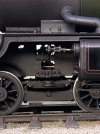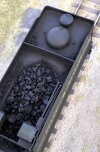You are using an out of date browser. It may not display this or other websites correctly.
You should upgrade or use an alternative browser.
You should upgrade or use an alternative browser.
Weathered Locos & Stock
- Thread starter Podartist79
- Start date
steve50
Western Thunderer
Thanks Neil, that all makes sense. It's the subtleness that I like. On first glance it doesn't look like too much has been done, but when you study it you can see all the different marks and grime that all comes together to make a very realistic model.I did Steve,
To confess though, I was a bit out of my depth initially regarding the worn-faded paintwork (not so much the fading).
Obviously the paint layers come through from below on the prototype and trying to make it look that way rather than other way around as it is on the model - for me - was tough.
I tried 2/3 methods, more by accident than design.
Essentially I put the chipped-damage layers onto the Masterpiece gloss top coat first, then worked over those (once dry) with the various semi-transparent oil layers. I then gently satin varnished over that and once dry, added some more body colour marks of slightly differing shades over the satin varnish (AK Acrylic) to gain the effect(s).
Hope that’s useful.
Neil.

Podartist79
Western Thunderer
Thank you Steve,Thanks Neil, that all makes sense. It's the subtleness that I like. On first glance it doesn't look like too much has been done, but when you study it you can see all the different marks and grime that all comes together to make a very realistic model.
I’m glad on studying the pictures you can see the subtlety and nuance of the work.
I do feel however, that I could’ve made more of some of the worn areas particularly, but that could be to the detriment and loss of the subtlety - and maybe then the realism - of the job.
Neil.
steve50
Western Thunderer
I've seen some of your work in 4mm, do you approach that any differently, I wonder if the smaller scales need an even more subtle approach?Thank you Steve,
I’m glad on studying the pictures you can see the subtlety and nuance of the work.
I do feel however, that I could’ve made more of some of the worn areas particularly, but that could be to the detriment and loss of the subtlety - and maybe then the realism - of the job.
Neil.
Podartist79
Western Thunderer
Hi Steve,
Yes, I tend to undertake 4mm scale models in a more subtle way than their 7mm scale counterparts.
I follow the same procedure(s) but apply less - to then remove - and probably apply the grime more thinly than in 7mm scale.
Hope that’s useful.
Neil.
Yes, I tend to undertake 4mm scale models in a more subtle way than their 7mm scale counterparts.
I follow the same procedure(s) but apply less - to then remove - and probably apply the grime more thinly than in 7mm scale.
Hope that’s useful.
Neil.
Yorkshire Dave
Western Thunderer
To confess though, I was a bit out of my depth initially regarding the worn-faded paintwork (not so much the fading).
Obviously the paint layers come through from below on the prototype and trying to make it look that way rather than other way around as it is on the model - for me - was tough.
I tried 2/3 methods, more by accident than design.
Essentially I put the chipped-damage layers onto the Masterpiece gloss top coat first, then worked over those (once dry) with the various semi-transparent oil layers. I then gently satin varnished over that and once dry, added some more body colour marks of slightly differing shades over the satin varnish (AK Acrylic) to gain the effect(s).
Hope that’s useful.
Neil.
Yes I would agree that, having weathered my own models, creating the faded look is tricky without making it appear as if has been 'added'. In some ways our modelling approach to weathering is akin to painting in oils starting with darker and working towards lighter colours. And of course there are the areas where muck, mud and grime stick around leaking oil and the brake dust 'burning' itself on. Let alone the cleaner areas from constant handling and/or walked upon.
Naturally in the real world paintwork is attacked by exposure to the sun (bleaching and UV light), attrition by minute abrasive particles carried by the wind and washing/scrubbing by rain which can be acidic or alkali depending on what it has absorbed during it's journey.
As I paint my own models I'm now working on trying to treat them like watercolours by starting with a thin coat of the base colour and add additional washes and/or coats to the darker areas where I need them, leaving the areas I want 'faded' untouched. This is still
Podartist79
Western Thunderer
John Duffy
Western Thunderer
Lovely stuff. You can almost smell the hot grease and oil.
Purple-haze
Western Thunderer
Neil,superb as always, and that last photo with the sun/light is stunning.
regards Rog
regards Rog
Podartist79
Western Thunderer
Thank you Both very much.
John Baker
Western Thunderer
Neil, it is, as always, fabulous! I know you have talked before about using the oil paints in layers on the paintwork to get the depth of colour and texture that you need, but can I ask how you achieve the oily look on the rods and motion? Is this oil paints too? Apologies if you've already covered this somewhere....
LarryG
Western Thunderer
Close up is when one sees the amount of work you have put into the weathering. Top class in my opinion.
On a prototype note, there isn't much space for hanging the sidebar supports and brake gear between the leading and middle drivers. Makes me wonder why designers made hard work for themselves (and fitters) when a few more inches between the wheels needn't have made a scrap of difference to the overall wheelbase.
On a prototype note, there isn't much space for hanging the sidebar supports and brake gear between the leading and middle drivers. Makes me wonder why designers made hard work for themselves (and fitters) when a few more inches between the wheels needn't have made a scrap of difference to the overall wheelbase.
michael mott
Western Thunderer
Neil your work is truly inspiring, the locomotive looks like it has just finished its first run on the Cornish express after rolling out of Swindon. That last photo is stunning!
Michael
Michael
Podartist79
Western Thunderer
Thank you John,Neil, it is, as always, fabulous! I know you have talked before about using the oil paints in layers on the paintwork to get the depth of colour and texture that you need, but can I ask how you achieve the oily look on the rods and motion? Is this oil paints too? Apologies if you've already covered this somewhere....
Thank you Larry also for your kind comments.
No problem describing the work on the rods.
I use oil paints over the factory/model finish, and once that’s dry, I go over that with Windsor & Newton Liquin Original. That is basically a glazing medium (layering) when painting on canvas but it does also provide a sheen, but a scale sheen I think. I’m also conscious to not make it too consistent. The more I look, even at clean motion, areas matt normally toward the centre of the rod, whereas, inevitably, the bosses remain pretty oily.
Hope that’s helpful.
NHY 581
Western Thunderer
Incredible stuff Neil, definitely art IMO.
Oh, I totally agree, Darling.
Pencarrow
Western Thunderer
Oh, I totally agree, Darling.
Thank you sweetie
Podartist79
Western Thunderer
Thank you Chris.Incredible stuff Neil, definitely art IMO.












